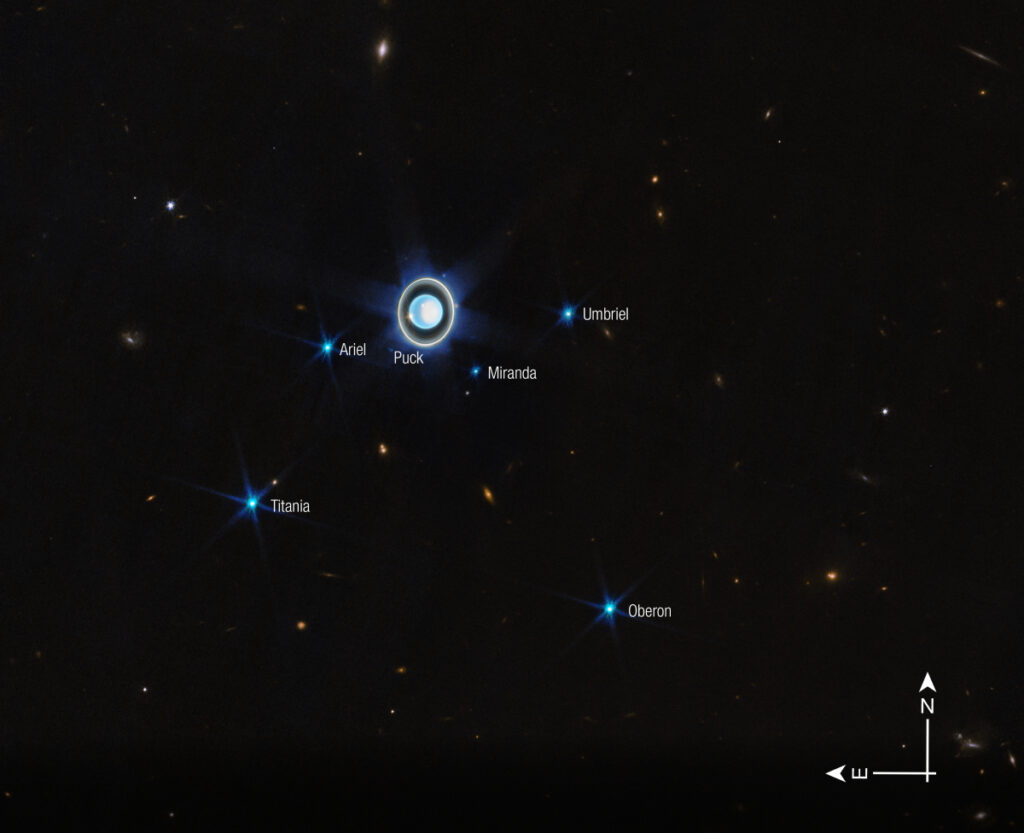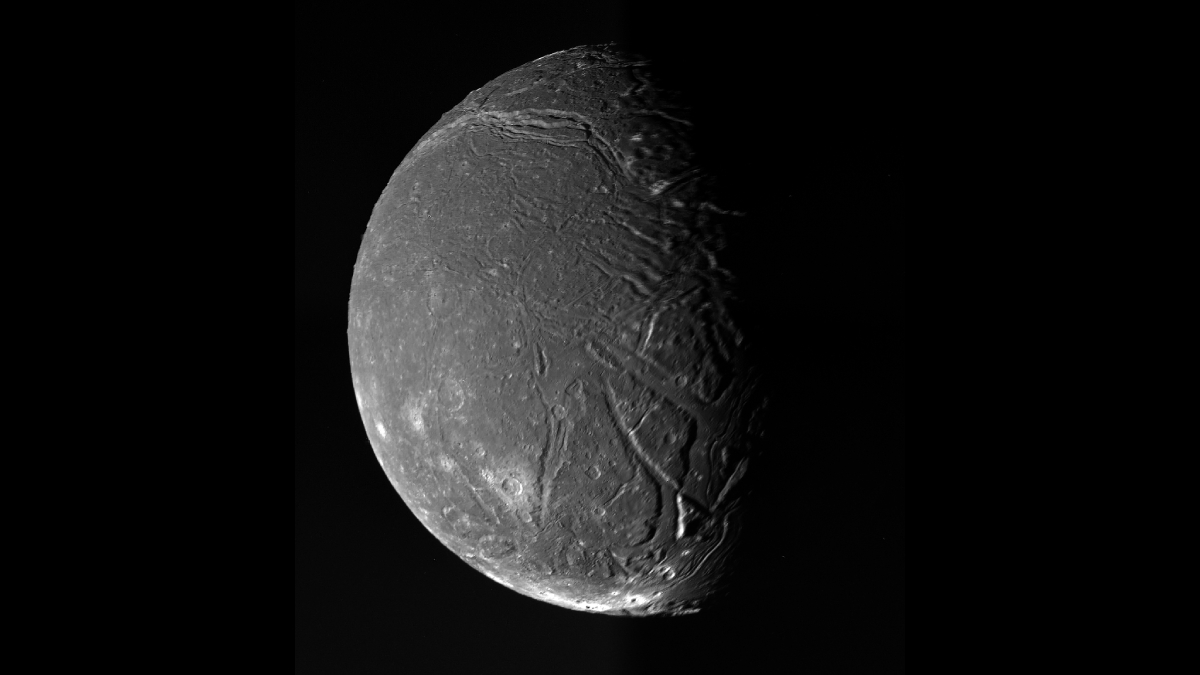Uranus’s tiny moon Ariel may have had a subsurface ocean that made up around 55% of its total volume. By mapping craters, crags, and ridges on the moon’s surface, planetary scientists modeled how thick Ariel’s crust was before it cracked under tidal stress and created the geologic features seen today. By subtracting the size of the crust and core, the researchers found that the Arielian ocean could have been about 170 kilometers thick as recently as 1 billion years ago.
“If Ariel had a subsurface ocean, it definitely does imply that other small icy moons could also have [had] subsurface oceans,” said Caleb Strom, who conducted this research as a planetary geologist fellow at the University of North Dakota in Grand Forks.
Maybe “it’s easier to make an ocean world than we thought,” he added.
An Unlikely Ocean World
Ariel is the second closest of the five large moons of Uranus. But large is a bit of a misnomer, as Ariel is only about 1,160 kilometers across, or about a third the size of Earth’s Moon.
When Voyager 2 flew through the Uranus system in 1986, scientists were surprised to see that Ariel’s icy surface was relatively young, was geologically complex, and showed some signs of cryovolcanism. Some features on the moon’s surface are similar to those seen on Europa, Enceladus, and Triton, three confirmed ocean worlds.
“We weren’t necessarily expecting it to be an ocean world.”
“What’s interesting about Ariel is that it’s unexpected,” Strom said. “We weren’t necessarily expecting it to be an ocean world.”
Later studies also found ammonia and carbon oxide compounds on Ariel’s surface, chemistry that often suggests the presence of subsurface liquid. The molecules disappear quickly unless they are frequently replenished.
But with Ariel being so small and unable to retain heat for very long, scientists thought that any subsurface ocean it may once have had was relatively thin and short-lived.
Strom and his colleagues didn’t initially set out to challenge this understanding of Ariel’s interior. They were interested in understanding the forces that could have created the moon’s geologic features.
To do this, the researchers first mapped the moon’s surface using images from the Voyager 2 flyby, cataloging ridges, fractures, and craters. They then modeled Ariel’s internal structure, giving it, from the top down, a brittle crust, a flexible crust, and an ocean all atop a solid core. They then simulated how that crust would deform under different levels of stress from tidal forces from other nearby Uranian moons and the planet itself. By varying the crust and ocean thickness and the strength of the tidal stress, the team sought to match the stress features in their models to the Voyager-derived geologic maps.

The team’s models indicate that a crust less than 30 kilometers thick would have fractured under a moderate amount of tidal stress and created the geologic features seen today. The researchers suggest that to cause that stress, in the past 1–2 billion years (Ga), an orbital resonance with nearby moon Miranda stretched Ariel’s orbit about 4% from circular and fractured the surface.
“This is really a prediction about the crustal thickness” and the stress level it can withstand, Strom said. Then, with a core 740 kilometers across and a crust 30 kilometers thick, that would mean that Ariel’s subsurface ocean was 170 kilometers from top to bottom and made up about 55% of its total volume. The researchers published their results in Icarus in September.
Is Ariel Odd? Maybe Not
“The possible presence of an ocean in Ariel in the past [roughly] 1 Ga is certainly an exciting prospect,” said Richard Cartwright, an ocean world scientist at Johns Hopkins Applied Physics Laboratory (JHUAPL) in Laurel, Md. “These results track with other studies that suggest the surface geology of Ariel offers key clues in terms of recent activity” and the possibility that Ariel is, or was, an ocean world. Cartwright was not involved with the new research.
Strom cautioned that just because Ariel once had a substantial subsurface ocean doesn’t mean that it still does. The moon is very small and doesn’t retain heat very well, he said. Any ocean that remained would likely be much thinner and probably not a good place to search for life.
However, the fact that tiny Ariel may once have had such a large ocean may mean that ocean worlds are more common and easier to create than scientists once thought. Understanding the conditions that led to Ariel’s subsurface ocean could help scientists better understand how such worlds come about and how they evolve.
“Ariel’s case demonstrates that even comparatively sized moons can, under the right conditions, develop and sustain significant internal oceans.”
“Ariel’s case demonstrates that even comparatively sized moons can, under the right conditions, develop and sustain significant internal oceans,” said Chloe Beddingfield, a planetary scientist also at JHUAPL. “However, that doesn’t mean all similar bodies would have done so. Each moon’s potential for an ocean depends on its particular mix of heat sources, chemistry, and orbital evolution.”
An ocean composing 55% of a planet’s or moon’s total volume might seem pretty huge, but it also might be perfectly within normal range for ocean worlds, added Beddingfield, who was not involved with this research. “The estimated thickness of Ariel’s internal ocean…is striking, but not necessarily unexpected given the diversity of icy satellites.”
Too, Voyager 2 did not image all of Ariel’s surface, only the 35% that was illuminated during its flyby. A future long-term mission to the Uranus system could provide higher-resolution global maps of Ariel and other moons to help refine calculations of crustal thickness and determine the existence of subsurface oceans, Strom said.
Strom and his team plan to expand their stress test research to other moons of Uranus such as Miranda, Oberon, and Umbriel and possibly icy moons around other planets.
—Kimberly M. S. Cartier (@astrokimcartier.bsky.social), Staff Writer

